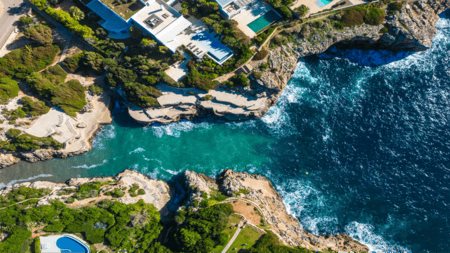The elegant suburb of Campsbay is firmly anchored in a central position along Cape Town ’s Atlantic Seaboard, and keeps company with exclusive neighbours Clifton, Bakoven and Llundudno.
Daily pleasures of living in this trendy suburb include overlooking the magnificent white beaches lined with palm trees, admiring the magnificence of the Twelve Apostle mountain range and Lions Head, or simply dining at one of many beachfront pavement eateries. As in the bygone era of the late 1800’s, Camps Bay beachfront and tidal pools remain a popular picnic site with locals and tourists. But instead of using the old tram service developed in 1901 for commuting between the city and Camps Bay, visitors now have access to a number of routes and several modern modes of transport.
Campsbay also offers property owners the exclusivity associated with high entry levels into this market, as well as property prices that have shown unprecedented growth during the past 8 years. Property prices here continued to perform exceptionally well during the global economic meltdown, unlike many other upmarket Cape coastal suburbs. Lightstone shows average freehold property prices here to have reached the highest levels since 2004, during the recession of R7 437 million in 2009. And the first three months of this year shows the highest ever average prices for sectional scheme properties in Campsbay to have achieved R3 880 million. But, those who are lured to invest in Campsbay say it is not only about sound property investments, but also about the vibrant cosmopolitan lifestyle it offers all residents, young and old.
The stately Twelve Apostles mountains were once covered in forests where wildlife roamed, where the lower slopes were home to a local Khoi tribe. And today this natural environment continues to offer locals breathtaking panoramic views and brilliant hiking trails, despite extensive development. This mountainous suburb has a reputation for offering brilliant wind shelter, that has become a strong marketing point with property professionals. Having remained largely undeveloped during the 19th century, this area was popular with the Governor of the Cape, Lord Charles Somerset for hunting for lion, leopard and antelope. The Governor’s hunting lodge and holiday accommodation was located at Campsbay’s famous landmark, the Roundhouse located in the forested Glen area bordering Clifton. Access between the city and coast became possible when Kloof Road was built in 1848, providing a route between Sea Point and Campsbay. Victoria Road, famous for spectacular elevated views between the two suburbs, built by Thomas Bain was named ‘Victoria Drive’, in honour of Queen Victoria's jubilee.
Campsbay has proudly retained its royal ranking, as is shown by Lightstone’s national suburb ranking to lead among SA’s first ten suburbs. Freehold property in Campsbay currently holds a national ranking of nine out of 5163 suburbs, and a municipal ranking of 6 out of 559 suburbs and average valuations of R7 356 576. Campsbay’s sectional scheme ranking is 6th out of 1 927 suburbs, and rates 5th on the municipal ranking out of 264 suburbs, with average valuations of R4 028 385.
Visitors enjoy easy access to Table Mountain and the city’s cultural and outdoor attractions, as well as the vibrant nightlife a mere 10 minutes away by car over Kloof Nek. Local entertainment includes worldclass performances at Pieter Toerien’s Little Theatre On The Bay, located opposite Campsbay beach.



